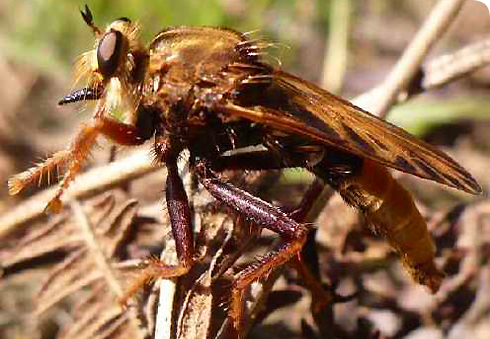Behaviour
Feeding
Asilus crabroniformis is a large predatory fly, both as an adult and as larvae.
Adult
The adults feed on a range of insects including grasshoppers, beetles, moths, butterflies, bees and wasps, and flies, typically those most associated with dung. They will also attack other robberflies, including their own species.
They generally hunt from bare ground or low lying vegetation including stumps and sticks. The adults are known to take 10-30 minutes to suck their prey dry!
Larvae
Not as much is known about the larvae, they are thought to feed on dung beetle larvae and other dung and soil-bourne invertebrates.
The larval hosts/prey species are presumed to be the larger species of dung beetles such as Geotropes or possibly Thphaeus (Smith 2000).
Pupation has been observed with the larvae forming their own burrow with pupation occurring within smooth lined cells, with adults emerging approximately 1 month later.
Flight
Adults fly from late June to late October when temperatures are about 16oC.
Toolbox
Follow the Curator of Diptera's blog

What happens behind the scenes in the Museum's Life Sciences Department? Curator Erica McAlister has about 30,000 species of fly to look after, and fieldwork trips at home and abroad. Her life is never dull!
Follow the blog